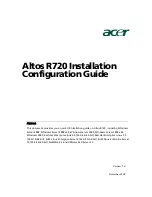
User’s Manual
Ethernet-Serial Server
GW5120
Copyright © 2009 Neteon Technologies, Inc.
All rights reserved.
1
1. Introduction
1.1. Overview
GW5120 Wireless Serial Server is a gateway between wireless LAN or Ethernet (TCP/IP) and
RS-232/RS-485 communications. It allows almost any serial devices to be connected to a new or
existing wireless network. The information transmitted by Serial Server is transparent to both host
computers (IP network over wireless LAN or Ethernet) and devices (RS-232/RS-485). Data from the
wireless LAN or Ethernet (TCP/IP) is transmitted to the designated RS-232/RS-485 port and data
from RS-232/RS-485 port is transmitted to the Wireless or Ethernet (TCP/IP) transparently.
In the computer integration manufacturing or industrial automation area, Wireless Serial Server is
used for field devices to direct connect to network. Terminal Server (main control program run in
GW5120) transforms whatever data received from RS-232/RS-485 to TCP/UDP port then connects
devices to the IP network via a single application program or multiple application programs.
Many control devices provide the ability to communicate with hosts through RS-232/RS-485 however
RS-232/RS-485 serial communication has its limitations. For instance, it is hard to transfer data
through a long distance. With GW5120, it is possible to communicate with a remote device in the
Intranet environment or even in the Internet and thus, increases the communication distance
dramatically.
Flexible configuration options enable this unit to be setup remotely over IP network by Telnet, web
browser, or Window utility. Packed in a rugged DIN Rail mountable case and 9~48V DC power input
range, GW5120 is ideal for almost any industrial and manufacturing automation.
1.2. Features
Dual-port DIN-Rail mounting module.
Metal housing with IP50 standard.
15KV ESD protection for serial ports
IEEE 802.11g 54Mbps wireless network connectivity
Support UDP, TCP server and client protocols for Virtual COM mode and pair connection
Selectable RS-232/RS-485/RS-422 serial mode by software
Configurable via console, telnet, built-in web server and Windows-based utilities
Standard 2.4GHz High-gain antenna
Upgradeable firmware via network







































